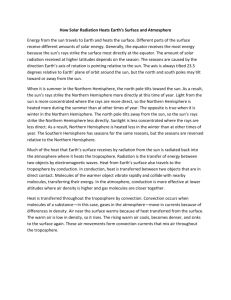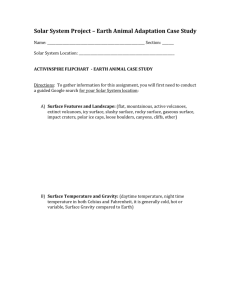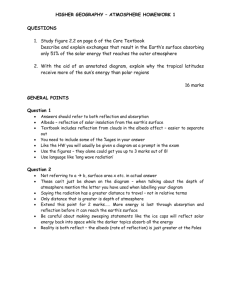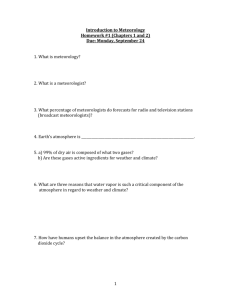Earth's Atmosphere and Its Seasons Notes pdf
advertisement
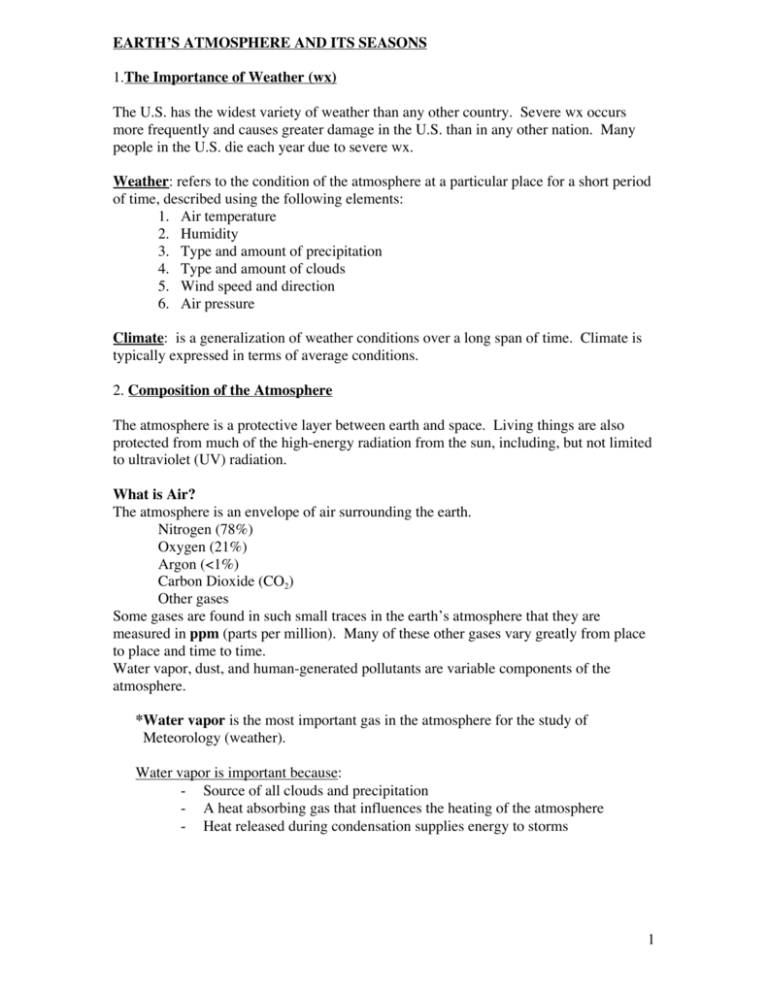
EARTH’S ATMOSPHERE AND ITS SEASONS 1.The Importance of Weather (wx) The U.S. has the widest variety of weather than any other country. Severe wx occurs more frequently and causes greater damage in the U.S. than in any other nation. Many people in the U.S. die each year due to severe wx. Weather: refers to the condition of the atmosphere at a particular place for a short period of time, described using the following elements: 1. Air temperature 2. Humidity 3. Type and amount of precipitation 4. Type and amount of clouds 5. Wind speed and direction 6. Air pressure Climate: is a generalization of weather conditions over a long span of time. Climate is typically expressed in terms of average conditions. 2. Composition of the Atmosphere The atmosphere is a protective layer between earth and space. Living things are also protected from much of the high-energy radiation from the sun, including, but not limited to ultraviolet (UV) radiation. What is Air? The atmosphere is an envelope of air surrounding the earth. Nitrogen (78%) Oxygen (21%) Argon (<1%) Carbon Dioxide (CO2) Other gases Some gases are found in such small traces in the earth’s atmosphere that they are measured in ppm (parts per million). Many of these other gases vary greatly from place to place and time to time. Water vapor, dust, and human-generated pollutants are variable components of the atmosphere. *Water vapor is the most important gas in the atmosphere for the study of Meteorology (weather). Water vapor is important because: - Source of all clouds and precipitation - A heat absorbing gas that influences the heating of the atmosphere - Heat released during condensation supplies energy to storms 1 Aerosols: tiny solid or liquid particles suspended in the air. Aerosols occur naturally and can also come from human sources. - Natural aerosols include ash from volcanoes and dust from dust storms - Human –generated aerosols include exhaust from cars and factories Water vapor needs a surface to condense on in the atmosphere and aerosols provide that surface. Without aerosols clouds could not form. Aerosols reduce the amount of sunlight reaching earth’s surface by: - Absorption - Reflection - Scattering Incoming solar radiation – insolation 3. Understanding Seasons The Sun is the source of all the energy that drives Earth’s wx and climate. Solar energy is not distributed evenly over Earth’s surface. The amount of energy received varies with: - Latitude - Time of day - Season of the year 2 Major Factors Change With The Seasons 1. Gradual changes in the length of daylight between Summer and Winter 2. The angle of the Sun above the horizon The closer the sun angle is to 90°, the more intense the solar rays. (Flashlight demonstration) The longer the path through the atmosphere the greater chance that sunlight will be absorbed, reflected, or scattered by the atmosphere, all of which reduce solar intensity at the surface. 4. Earth-Sun Relationships Earth has 2 primary motions in relation to the sun 1. Rotation- spinning of Earth on its axis. Rotation produces daily cycle of daylight and darkness. One rotation takes 24 hours. 2. Revolution- the movement of Earth in its orbit around the Sun. One revolution takes 365 1/4 days, or one solar year. What causes seasonal variations in Sun angle and length of daylight? - Earth’s axis of rotation tilts 23 1/2° - June 21-22, Earth’s northern hemisphere “leans” 23 1/2° toward the sun - December 21-22 Earth’s northern hemisphere “leans” 23 1/2° away from the sun 2 4 days each year have a special designation based on the annual migration of the direct rays of the Sun: - June 21-22. The noon vertical rays of the sun strike 23 1/2° north, the Tropic of Cancer – Summer Solstice northern hemisphere and Winter Solstice in the southern hemisphere. - December 21-22. The noon vertical rays of the sun strike 23 1/2° south, the Tropic of Capricorn – Summer Solstice southern hemisphere and Winter Solstice in the northern hemisphere. - March 21-22. The noon vertical rays of the sun strike the equator. Spring (Vernal) Equinox in the northern hemisphere and Fall (Autumnal) Equinox in the southern hemisphere. - September 22-23. The noon vertical rays of the sun strike the equator. Spring (Vernal) Equinox in the southern hemisphere and Fall (Autumnal) Equinox in the northern hemisphere. 5. Sun Angle and the Seasons Calculating the Noon Sun Angle Location: 30° S Date: June 21-22 Location of 90° Sun: 23 1/2° N Calculations Step 1 Distance in degrees between 23 1/2° N and 30° S = 30° + 23.5° = 53.5° Step 2 90° - 53.5° = 36.5° (Noon angle of Sun at 30° S on June 21-22) Analemma: device found on some globes or maps that help us locate the Sun’s vertical rays for a given place and time. a. Use the Analemma to determine the location of the Sun’s vertical (90°) rays on a given date. 2. Determine the distance, in degrees, between the latitude receiving the Sun’s vertical rays and the given location. 3. Subtract the distance determined in step 2 from 90° E.g. Calculating Sun angle for 40° N 1. October 14th – vertical rays of the Sun strike the Earth at 8° S latitude. 2. Distance between 8° S and 40° N = 48° N 3. 90° - 48° = 42° (angle of the Sun’s rays for Oct. 14th at 40° N) 6. Solar Radiation Solar energy makes its way to Earth by an energy transfer mechanism termed radiation. The sun emits radiation in the form of light and heat as well as the U.V. rays that cause skin to “burn” and or “tan”. 3 When an object absorbs any form of radiation, the result is an increase in temperature. Basic Laws of Radiation 1. All objects, at whatever temperature, emit radiant energy. 2. The hotter the radiating body, the shorter the wavelength of maximum emission. 3. Gases are selective absorbers of radiation. a. Gases in the atmosphere are good absorbers and emitters of some wavelengths but do not absorb other wavelengths. b. Specifically, Earth’s atmosphere is a relatively poor absorber of insolation (incoming solar radiation). We know this because much of it reaches Earth’s surface as visible light. As Earth’s surface absorbs and is heated by solar radiation, it emits long wave energy back to the atmosphere. 7. What happens to Incoming Solar Radiation? What are the Paths of solar radiation? During its journey through the atmosphere, solar energy is either scattered, reflected, or absorbed. Scattering: process by which gases and tiny particles in the atmosphere redirect solar energy. Reflection: process by which waves bounce off surfaces that they cannot pass through. ≈ 30% of solar energy intercepted by Earth is reflected or scattered back to space. Radiation that is reflected or scattered back to space is not absorbed, and therefore, does not heat Earth. Absorption: process by which radiation strikes an object and increases the motion of its molecules. The result is an increase in the object’s temperature. ≈ 50% of the incoming solar radiation passes through the atmosphere and is absorbed at Earth’s surface. Albedo: the percentage of light reflected by an object. Albedo varies due to: 1. cloud cover 2. nature of the surface 3. sun angle 8. The Greenhouse Effect - term used to describe the process by which the atmosphere is heated. The Earth heats the atmosphere not the Sun. The earth absorbs short wave incoming solar radiation and converts it into long wave radiation (infrared or heat energy). Atmospheric gases more easily absorb these longer waves. The primary heat-absorbing gases in the atmosphere are carbon dioxide (CO2) and water vapor. 4 The Earth absorbs incoming solar radiation and reradiates long wave energy back to the atmosphere where water vapor and CO2 absorb it, which heats the air. Global warming is related to the Greenhouse Effect. Burning fossil fuels increases atmospheric CO2, which is a Greenhouse gas. 9. Basic Temperature Data 1° C is higher than 1° F by a factor of 1.8. ° F = (1.8 X ° C) + 32 ° C = ° F - 32 1.8 E.g. 41° F = 41-32 = 9 = 5° C 1.8 1.8 18° C = 1.8 X 18 = 32.4 + 32 = 64.4° F A thermograph is a machine that continuously records temperatures. The most basic temperature data regularly collected are the maximum and minimum temperatures at a particular location. The minimum daily temperature most often occurs around sunrise. The maximum temperature usually occurs between 2 and 5 P.M. Daily Mean Temperature: the average of the maximum and minimum temperatures for the day. E.g. 86° F High temperature for the day 68° F Low temperature for the day 86° + 68° = 154 ÷ 2 = 77° F Daily Temperature range: Subtract daily minimum temperature from daily maximum temperature. Monthly Mean Temperature: calculated by adding together the daily means for each day of the month and dividing by the number of days in the month. Annual Mean Temperature: is an average of the 12 monthly means. Add 12 monthly means and divide by 12. Annual Temperature Range: computed by finding the difference between the warmest and coolest monthly mean temperatures. Isotherm: a line that connects points of equal temperature. 5 10. Controls of Temperature A temperature control is any factor that causes temperatures to vary from place to place and from time to time. The most important temperature control is variation in solar radiation due to changes in Sun angle and length of daylight. Other Temperature Controls b. Latitude c. Differential Heating of Land and water d. Ocean Currents e. Altitude f. Geographic Position Highest Temperature ever recorded on Earth was in Azizia, Libya on September 13, 1922. The temperature was 136° F. Coldest temperature ever recorded on Earth was in Antarctica (Russian research station). The temperature was recorded at –129° F on August 24, 1960. POSSIBLE LAB OPTIONS FOR CHAPTER ONE 1. 2. 3. 4. 5. 6. Differential Heating of Land and Sea. Albedo (Dark vs. Light Color Objects). Greenhouse Effect. Distribution of Heat by Convection Current in a Fluid. Light Colored land (sand) vs. Dark Colored Land (soil) – Albedo. Opaqueness of Sand (Temperatures greater nearer to the surface than under ground). 7. Conduction of liquids and solids. 8. Convection current in the classroom. 6



